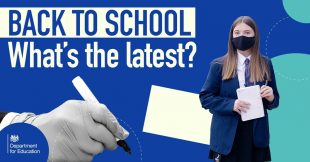
Today, the majority of schools across the country welcomed their students back to school after the Easter Break.
While there have been a lot of changes and challenges over the past year, we remain committed to ensuring all children have access to good quality education no matter their background.
Here’s the lowdown on everything you need to know about the return to the classroom for the Summer term.
Has anything changed since before the Easter break?
The additional safety measures that were put in place before the Easter break remain. These include staggered starts and breaks, desks facing forwards, additional hygiene, and ventilation.
The main difference is that all tests are now to be taken at home. These will be provided to students and staff as lateral flow device (LFD) testing kits by their school or college to take home.
We ask that teachers and school staff, secondary school pupils and college students, and the households of pupils in school and college – this includes family members, childcare and people in support bubbles – to all take the LFD tests twice a week. Primary school pupils are not currently being asked to take tests.
We have developed some useful links on home testing. For translated self-test guidance on how to self-test, please see here. For a step-by-step demonstration video with Dr Amir Khan, please see below.
You may be helping your child do their first Covid-19 test at home tonight.@DrAmirKhanGP demonstrated how to carry out a lateral flow test, with the help of his niece. #BackToSchool pic.twitter.com/Jjp1r4gT7t
— Department for Education (@educationgovuk) March 23, 2021
Thanks to testing, even students and family members who are asymptomatic are able to isolate early on, helping to protect other families and keep COVID-19 out of the classroom.
What is the current situation with face masks in schools?
In line with public health advice and based on evidence from the last few weeks, face coverings should continue to be worn by adults and those in Year 7 and above as a precautionary measure.
Face coverings have been required in secondary schools and colleges and for adults in primary schools since the return to education on 8 March. We said we would review the policy over Easter and continue to follow the best advice.
Future consideration of the face coverings policy will be aligned with step 3 of the roadmap process (no earlier than 17 May).
Are you confident that my child’s education will not be further interrupted?
We want this step of the roadmap to be irreversible. At the end of last term, attendance in schools remained higher than at any point during the autumn term, as students and staff continued to follow the protective measures set out to reduce transmission of the virus.
We are confident that as we progress through the summer term, with the testing programme in full swing and millions of tests being conducted each week, we will continue to see just a small increase in the numbers of students testing positive and self-isolating.
What is being done to help children catch up on missed classroom learning?
Getting children back to school is only the start of our plan. We know there has been an impact on children and that is why we’re spending £1.7 Billion including the latest £700 million to help children catch up to boost learning and wellbeing, with ongoing one-to-one tuition launched last year and summer schools during the holidays.
What about getting to and from school? What do you recommend?
If pupils live a short distance from their school or college, they are advised to walk or cycle if they can.
It is also advised that pupils and students should avoid sharing a car with anyone outside of their household or support bubble. If pupils are using public transport to get to school or college, it is recommended they plan ahead and allow more time for their journey.
Where pupils are travelling to school by public transport, it is important to remember to:
- Wear a face covering unless exempt, including if the child is aged 11 and under
- Keep their distance where possible
- Sanitise their hands regularly
- Be considerate to fellow passengers and staff.